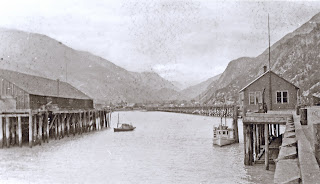
Another Canadian Pacific Railroad liner, the Princess Kathleen, grounded on Lena Point during a fierce squall and sank northwest of Juneau on this day, September 7, 1952.
Fortunately the over 400 passengers and crew were able to climb ashore with no loss of life. The massive ship now rests on her port side in around 80-140 feet of water. Like the Sophia, limited visibility and strong currents frequent the wreck site. Located relatively close to Juneau, the site is a popular recreational dive destination. Since the sinking, periodic fuel releases and oil sheens have been noted in the vicinity. The vessel sits at an angle on its port side at a depth ranging from 52 feet at the bow to 134 feet at the stern.
Recent inspection of the ship’s integrity showed it to be coming apart since the rivets have mostly disintegrated.
Small amounts of oil will still be released at the site, since dive crews could not scrub the ship clean. The leaks will result in small oil sheens on the surface, as had been observed before the work.
The cost to recover about 110,000 gallons of bunker oil from the ship has surpassed $10 million and likely will cost more than $12 million, U.S. Coast Guard officials said.
Federal funding to pay for the oil removal project will come from the Oil Spill Liability Trust Fund, the emergency fund discussed as a source for cleanup in the Gulf of Mexico associated with BP’s oil rig explosion.
Project coordinators with the U.S. Coast Guard and state officials consider the Juneau project a major success. Removing the oil eliminates the potential for a large environmental disaster, Alaska On-Scene Spill Response Coordinator Scot Tiernan said.
The price tag also is worth it, U.S. Coast Guard Response Chief Cmndr. Kurt Clarke said.
Juneau Empire article from June 13, 2010.








